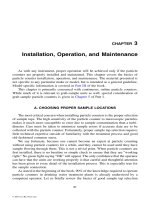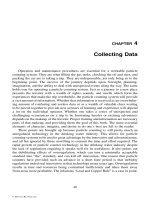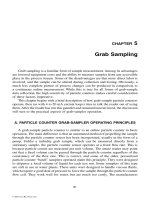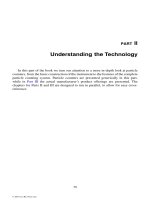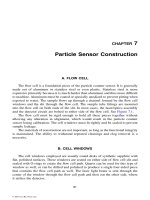Particle development for drug delivery
Bạn đang xem bản rút gọn của tài liệu. Xem và tải ngay bản đầy đủ của tài liệu tại đây (5.32 MB, 284 trang )
PARTICLE DEVELOPMENT FOR DRUG DELIVERY
LEE CHIN CHIAT
NATIONAL UNIVERSITY OF SINGAPORE
2004
PARTICLE DEVELOPMENT FOR DRUG DELIVERY
LEE CHIN CHIAT
B. Sc. (Pharm) (Hons)
A THESIS SUBMITTED
FOR THE DEGREE OF DOCTOR OF PHILOSOPHY
DEPARTMENT OF PHARMACY
NATIONAL UNIVERSITY OF SINGAPORE
2004
To my wife, parents and sister,
whom I am greatly indebted to.
ACKNOWLEDGMENTS
I wish to express my thanks and appreciation to my supervisors, Associate Professor
Paul Heng Wan Sia and Associate Professor Chan Lai Wah, for their constant care
and guidance throughout the course of my higher degree.
I am grateful to the GEANUS Pharmaceutical Processing Research Laboratory,
Department of Pharmacy, for the use of the research facilities, as well as to the
National University of Singapore, for providing the postgraduate research scholarship.
My thanks go to Teresa, Mei Yin, Celine, Tin Wui and Charlene for their technical
assistance, and to Professor Lucy Wan and Dr. Anthony Yolande, for their lessons
about life.
I definitely need to thank Liang Theng, Sze Nam, Kang Teng and Gu Li, for their
companionship, encouragement, suggestions and support. Without them, my stay
would not have been so memorable.
Chin Chiat
1
st
January 2004
i
Table of Contents
TABLE OF CONTENTS
Page
ACKNOWLEDGMENTS i
TABLE OF CONTENTS ii
SUMMARY x
LIST OF FIGURES xiii
LIST OF TABLES xix
I. INTRODUCTION 1
A. Dissolution 1
A1. Poorly Soluble Drug 1
A2. Strategies in Enhancing Dissolution Rate 3
A3. Particle Shape and Dissolution 5
B. Particle Shape 7
B1. Concept of Particle Shape 7
B2. Shape Factors 7
B2.1 Static Shape Factors 7
B2.1.1 Geometric Shape Factors 9
B2.1.2 Fourier Series in Shape Generation 13
B2.1.3 Fractal Analysis 15
B2.2 Dynamic Shape Factors 18
C. Particle Size 19
C1. Concept of Particle Size 19
C2. Particle Size Measurement 19
C2.1 Image Analysis and Microscopy 25
C2.2 Diffraction 26
ii
Table of Contents
C3. Size Reduction 27
C3.1 Milling 30
C3.1.1 Theory of Milling 30
C3.1.1.1 Fracture Mechanism 32
C3.1.1.2 Circuit Design 34
C3.1.1.3 Energy Consideration 34
C3.1.2 Milling Equipment 35
C3.1.2.1 Ball Mill 35
C3.1.2.2 Hammer Mill 37
C3.1.2.3 Fluid Energy Mill 37
C3.1.3 Effects of Milling on Crystallinity 38
C3.1.4 Effects of Milling on Particle Shape 40
C4. Size Classification 41
C4.1 Screening 41
C4.2 Fluid Force Classification 42
C4.2.1 Dry Classification 42
C4.2.2 Wet Classification 45
D. Ordered / Interactive Mixtures 48
D1. Definition 48
D2. Factors Affecting Dissolution Rates 50
E. Solid Dispersions 53
E1. Definition 53
E2. Preparation Methods 53
E2.1 Melt / Fusion Method 53
E2.2 Solvent Method 54
iii
Table of Contents
E2.3 Melt-Solvent Method 55
E3. Types of Physicochemical Structure of Solid Dispersions 55
E3.1 Theoretical Physicochemical Structures 55
E3.1.1 Eutectic Systems 56
E3.1.2 Solid Solutions 56
E3.1.2.1 Continuous Solid Solutions 58
E3.1.2.2 Discontinuous Solid Solutions 58
E3.1.2.3 Substitutional Crystalline Solid Solutions 60
E3.1.2.4 Interstitial Crystalline Solid Solutions 60
E3.1.3 Monotectic Systems 60
E3.1.4 Amorphous / Glassy Solid Solutions 62
E3.1.5 Complex Systems 62
E3.2 Actual Physicochemical Structures 63
E4. Factors Affecting Dissolution Rates 64
E4.1 Nature of Drug and Carrier 64
E4.2 Concentration of Carrier 65
E4.3 Molecular Weight of Carrier 68
E4.4 Process Variables 68
E5. Stability of Solid Dispersions 69
E6. Scale Up of Solid Dispersion Production 70
II. OBJECTIVES 73
A. Particle Development 73
B. Dissolution Enhancement of a Practically Insoluble Drugs 73
III. EXPERIMENTAL 74
A. Materials 74
iv
Table of Contents
A1. Model Crystalline Material 74
A2. Practically Insoluble Model Drug 74
A3. Model Carrier 75
A4. Reagents 75
B. Methods 76
B1. Fluidised Bed (FB) Hammer Mill 76
B1.1 Milling Process 76
B1.1.1 Influence of Beater Rotational Speed 79
B1.1.2 Influence of Classifier Wheel Rotational Speed 79
B1.1.3 Influence of Airflow Rate 79
B1.1.4 Influence of the Length of Grinding Zone 80
B1.1.5 Influence of Starting Material 80
B1.1.6 Combinations of Process Variables 80
B1.2 Particle Characterisation 80
B1.2.1 Size Analysis by Laser Diffraction 80
B1.2.1.1 Rosin-Rammler Distribution (RRD) Function 84
B1.2.1.2 Size at 99
th
Percentile of the Cumulative Undersize
Distribution (D
99
) 85
B2. Fluidised Bed Opposed (FBO) Jet Mill 86
B2.1 Micronisation Process 86
B2.1.1 Influence of Classifier Wheel Rotational Speed 88
B2.1.2 Influence of Feed Load 88
B2.1.3 Influence of Micronising Air Pressure 89
B2.1.4 Combinations of Process Variables 89
B2.2 Particle Characterisation 91
v
Table of Contents
B2.2.1 Size Analysis by SEM 91
B2.2.2 Shape Determination by Image Analysis 92
B3. Air Classifying System 96
B3.1 Air Classifying Process 96
B3.1.1 Influence of Classifier Wheel Rotational Speed 98
B3.1.2 Influence of Starting Material 98
B3.1.3 Influence of Airflow Rate 100
B3.1.4 Combinations of Process Variables 100
B3.2 Particle Characterisation 100
B3.2.1 Size Analysis by Laser Diffraction 100
B4. Dissolution Enhancement of Nifedipine 103
B4.1 Nifedipine 103
B4.2. Preparation of Nifedipine, Interactive Mixtures and Solid
Dispersions 103
B4.2.1 Processing of Nifedipine to Obtain Different Size Fractions 103
B4.2.2 Preparation of Interactive Mixtures 103
B4.2.3 Preparation of Solid Dispersions 105
B4.2.4 Codes Employed 106
B4.3 Characterisation of Interactive Mixtures and Solid Dispersions 107
B4.3.1 Dissolution Studies 107
B4.3.2 Determination of Equilibrium Solubility of Nifedipine 108
B4.3.3 Surface Tension Study 108
B4.3.4 Size Analysis by Laser Diffraction 109
B4.3.5 Crystallinity Determination by Powder X-Ray Diffraction
(PXRD) 110
vi
Table of Contents
B4.3.6 Phase Study Using Differential Scanning Calorimetry (DSC) 110
B4.4 Statistical Analysis 111
IV. RESULTS AND DISCUSSION 112
A. FB Hammer Mill 112
A1. Rationale for the Choice of Equipment and Method Employed 112
A1.1 Rationale for Choosing FB Hammer Mill 112
A1.2. Rationale for Choosing Laser Diffraction for Particle Sizing 113
A1.3 Rationale for Using RRD Function 114
A2. Characteristic of Starting Materials 114
A3. Factors Affecting the FB Hammer Milling Process 119
A3.1 Influence of Beater Rotational Speed and Starting Materials 119
A3.2 Influence of Classifier Wheel Rotational Speed and Starting
Materials 126
A3.3 Influence of Airflow Rate and Starting Materials 129
A3.4 Influence of the Length of Grinding Zone and Starting Materials 131
A3.5 Relative Importance of the Process Variables and Starting
Materials 134
A4. Complementary Roles of D
e
and D
99
135
B. FBO Jet Mill 136
B1. Rationale for the Choice of Equipment and Method Employed 136
B1.1 Rationale for Choosing FBO Jet Mill 136
B1.2 Rationale for Choosing SEM for Particle Sizing 137
B1.3 Choice of Characterising Parameters 138
B2. Factors Affecting the Micronisation Process with Respect to Particle
Size 143
vii
Table of Contents
B2.1 Influence of Classifier Wheel Rotational Speed 143
B2.2 Influence of Feed Load 148
B2.3 Influence of Micronising Air Pressure 155
B2.4 Relative Importance of the Process Variables 156
B3. Complementary Roles of D
50
and D
99
157
B4. Shape Determination By Image Analysis 157
B4.1 Rationale for Studying Particle Shape 157
B4.2 Rationale for the Choice of Method 158
B4.3 Rationale for the Choice of Process Conditions 159
B4.4 Rationale for Employing Nonparametric Statistics 159
B5. Influences of Process Variables on Particle Shape 159
B5.1 Influence of Classifier Wheel Rotational Speed 159
B5.2 Influence of Feed Load 166
B6. Potential Monitoring Indicators for the Micronisation Process 169
B7. Difference Between Size and Shape Characterising Systems 169
C. Air Classifying System 170
C1. Rationale for Studying the Air Classifying System 170
C2. Factors Affecting the Air Classification Process 170
C2.1 Influence of Classifier Wheel Rotational Speed 170
C2.2 Influence of Starting Material 179
C2.3 Influence of Airflow Rate 180
C3. Complementary Roles of D
50
and D
99
181
D. Nifedipine Dissolution Enhancement 181
D1. Preparation of Nifedipine with Different Particle Sizes 181
D2. Rationale Behind the Preparation of Solid Dispersion 184
viii
Table of Contents
D2.1 Choice of Temperature 184
D2.2 Choice of Solid Dispersion Particle Size Employed 185
D3. Equilibrium Solubility of Nifedipine 185
D4. Dissolution Profiles of Nifedipine 187
D4.1 Pure Nifedipine Powders 187
D4.2 Interactive Mixtures 196
D4.3 Solid Dispersions 202
D4.4 PXRD and DSC Phase Analysis 205
D4.5 Mechanism of Drug Dissolution from Interactive Mixtures and
Solid Dispersions 211
D5. Dissolution Mechanism and Implications 214
V. CONCLUSIONS 215
A. Particle Development 215
B. Dissolution Enhancement of a Practically Insoluble Drug 218
VI. REFERENCES 219
VII. APPENDICES 251
VIII. PUBLICATIONS 259
ix
Summary
SUMMARY
Enhancing the dissolution of poorly soluble drugs has always been a challenge to
researchers. It was known that the solubility of this class of drugs was affected by
particle size and shape of the drugs, and common industrial unit processes affected
these two morphological features. In view of this, two industrial unit processes,
namely milling and particle classification were studied. For the milling process, a
fluidised bed (FB) hammer mill (50 ZPS, Hosokawa Micron Corporation) and a
fluidised bed opposed (FBO) jet mill (100 AFG, Hosokawa Micron Corporation) were
chosen whereas for particle classification, an air classifying system (50 ATP,
Hosokawa Micron Alpine) was selected for investigation. The effects of process
variables such as beater rotational speed, classifier wheel rotational speed, airflow rate
and length of grinding zone of the FB hammer mill and the particle size and
flowability of starting materials on the particle size and size distribution of the milled
products were investigated. All the milled batches of products could be described by
the Rosin-Rammler distribution (RRD) function. The characterising parameters of the
RRD function, D
e
and n, together with the value at 99
th
percentile of the cumulative
undersize distribution (D
99
), were used to correlate the process variables and
characteristics of the starting materials to the products. Increasing milling energy
input as indicated by the increasing rotational speed of the beater system resulted in
the production of finer products with narrower particle size distributions. Beater
rotational speed also exerted a strong influence on the other process variables. At
high beater rotational speeds of 18000 and 21000 rpm, the influence of starting
materials and length of grinding zone would be reduced; particles with D
99
value less
than 22.73 µm could be produced with high classifier wheel rotational speed of 15000
rpm; and slightly coarser particles could be produced at higher airflow rate of
x
Summary
90 m
3
/ h. Low beater rotational speeds 12000 and 15000 rpm, caused a loss of
classifier wheel efficiency, resulting in milled products with large particle sizes and
broad particle size distributions.
For FBO jet mill, the process variables investigated were the rotational speed of the
classifier wheel, levels of feed load and micronising air pressure. The micronised
products produced by FBO jet mill could not be described by the RRD function, log-
normal, Weibull and gamma functions. Span and values at 5
th
(D
5
), 50
th
(D
50
) and the
99
th
(D
99
) percentile cumulative undersize of the products were employed for
correlation study between the process variables and micronised batches of particles.
Increasing classifier wheel rotational speed from 5000 rpm to 15000 rpm, was found
to produce products with finer particle sizes and narrower particle size distributions.
The operation of classifier wheel was not affected by the operations of the other two
process variables. A low feed load of 250 g with high micronising air pressure of 0.5
MPa brought about a start-up loss of classifier wheel efficiency because of the rapid
fluidisation of the feed load. The same process conditions did not bring about gross
variation in particle shape. However a high feed load of 450 g brought about a loss in
classifier wheel efficiency producing particles bigger in size with broader particle size
distribution, and less uniform in shape. It was found that particle shape and size were
not correlated, thus conditions that caused the start-up loss of classifier wheel
efficiency with respect to particle size, were not applicable to particle shape.
Depending on the morphological characteristics needed, the relevant characterising
systems should be employed.
xi
Summary
In the air classifying system, increasing classifier wheel rotational speed resulted in
larger particles with broader particle size distribution being collected in the fine
fraction. This was attributed to the higher vibration experienced when the classifier
wheel was rotated at higher speeds and forced entry of large particles due to rebounds
off the classifying chamber wall brought about by high centrifugal force of the
rotating classifier wheel. Starting material with bigger particle size and good
flowability would further confound this. The employment of smaller particle size and
poorer flowability starting material would result in the production of slightly coarser
particles at a high airflow rate of 90 m
3
/ h.
Sieving, FB hammer mill and FBO jet mill were selected to produce nifedipine with
four different particle sizes. Successful enhancement of nifedipine dissolution could
be achieved when the different batches of nifedipine were formulated into interactive
mixtures or solid dispersions with polyethylene glycol 3550 (PEG 3350), as a soluble
carrier, as compared to the unformulated states. The dissolution mechanism for
nifedipine solid dispersions followed the drug-controlled model as proposed by Craig
and Newton (1992). The mechanisms of dissolution of interactive mixtures and solid
dispersions were found to be essentially the same. The dissolution mechanisms of the
two systems were dependent on the final nifedipine particle size, degree of wetting,
degree of deaggregation of the nifedipine particles and the crystallinity of nifedipine
and PEG 3350.
xii
List of Figures
LIST OF FIGURES
Page
Figure 1. Schematic illustration of the dissolution process of oral
pharmaceuticals.
2
Figure 2. (a) Analytic particle and (b) non-analytic particle, illustrating the
vector intersecting with the surface of the particle.
8
Figure 3. Geometric signature waveform of a particle. (P, Pivot Point; R,
Vector; R
L
, Largest Vector;
θ
, Angle) (Modified from Singh and
Ramakrishnan, 1996)
11
Figure 4. Different geometric signature waveforms generated from a shift
of pivot point from (a) the centre to (b) the side of a hypothetical
rectangular particle. (Singh and Ramakrishnan, 1996)
12
Figure 5. Fractal dimensions of various contours (Carstensen and
Franchini, 1993a).
17
Figure 6. The major classifications of sizing techniques.
21
Figure 7. Stress-strain profile of a substance.
31
Figure 8. Air-assisted screening equipment (Hidaka, 1997).
43
Figure 9. Displacement of coarse, medium and fine particles while
transversing airflow. The directions of gravity and airflow are
(a) perpendicular and (b) parallel to each other (Iinoya and
Tanaka, 1997).
44
Figure 10. Diagram of a cyclone illustrating the separation of coarse from
fine particles.
46
xiii
List of Figures
Figure 11. Diagrams of (a) a gravity settling tank and (b) a rake classifier
(Heiskanen, 1993)
47
Figure 12. Phase diagrams of (a) eutectic system, (b) discontinuous solid
solution and (c) monotectic system.
57
Figure 13. Phase diagram of a continuous solid solution of a binary system.
59
Figure 14. (a) Substitutional crystalline solid solution, (b) interstitial
crystalline solid solution, (c) interstitial solid solution of small
molecules in the crystalline parts of the polymer and (d)
amorphous solid solution (Leuner and Dressman, 2000).
61
Figure 15. Diagram showing the effect of drug concentration in solid
dispersion on the drug dissolution rate, as measured from
constant surface area discs (Ford, 1986b).
66
Figure 16. Schematic diagram of the major components of a FB hammer
mill. (A, Feeder; B, Milling Chamber; C, Classifier Wheel; D,
Beater System; E, Grinding Track; F, Fluidisation Air Inlet; G,
Cyclone; H, Filter; I, Superfine Collection Bin; J, Product
Collection Bin; K, Blower)
77
Figure 17. Schematic diagrams illustrating impact of an oncoming particle
onto the (a) short and (b) long grinding zones. (A, Grinding
Track; B, Beater System)
78
Figure 18. Schematic diagram of the major components of a FBO jet mill.
(A, Feeder; B, Micronising Chamber; C, Classifier Wheel; D,
Cyclone; E, Filter; F, Blower; G, Product Collection Bin; H,
Superfine Collection Bin; I, Base Nozzle; J and K, Side Nozzles)
87
Figure 19. Pictorial representation of area, perimeter, length and breadth. 94
xiv
List of Figures
Figure 20. Schematic diagram of the major components of an air classifying
system. (A, Feeder; B, Classifying Chamber; C, Classifier
Wheel; D, Vane Ring; E, Coarse Product Collection Bin; F, Air
Inlet; G, Cyclone; H, Fine Product Collection Bin; I, Filter; J,
Superfine Collection Bin; and K, Blower)
97
Figure 21. (a) Side view and (b) planar view of the vane ring illustrating
redirection of air to form the vortex for air classification.
99
Figure 22. A typical plot of particle size distributions of fine and coarse
fractions illustrating intersection cut size and percentage overlap.
(Cumulative oversize of fine fraction: ; Cumulative
undersize of coarse fraction: ).
102
Figure 23. Plots of D
99
against beater rotational speed at (a) classifier wheel
rotational speed of 5000 rpm, airflow rate of 80 m
3
/ h and long
grinding track; (b) classifier wheel rotational speed of 15000
rpm, airflow rate of 80 m
3
/ h and long grinding track; (c)
classifier wheel rotational speed of 5000 rpm, airflow rate of 90
m
3
/ h and long grinding track and (d) classifier wheel rotational
speed of 5000 rpm, airflow rate of 80 m
3
/ h and short grinding
track. (Lactose 100 M, ; lactose 150 M, ; lactose 200 M,
U)
120
xv
List of Figures
Figure 24. Plots of n against beater rotational speed at (a) classifier wheel
rotational speed of 5000 rpm, airflow rate of 80 m
3
/ h and long
grinding track; (b) classifier wheel rotational speed of 15000
rpm, airflow rate of 80 m
3
/ h and long grinding track; (c)
classifier wheel rotational speed of 5000 rpm, airflow rate of 90
m
3
/ h and long grinding track and (d) classifier wheel rotational
speed of 5000 rpm, airflow rate of 80 m
3
/ h and short grinding
track. (Lactose 100 M, ; lactose 150 M, ; lactose 200 M,
U)
121
Figure 25. Plots of D
e
against beater rotational speed at (a) classifier wheel
rotational speed of 5000 rpm, airflow rate of 80 m
3
/ h and long
grinding track; (b) classifier wheel rotational speed of 15000
rpm, airflow rate of 80 m
3
/ h and long grinding track; (c)
classifier wheel rotational speed of 5000 rpm, airflow rate of 90
m
3
/ h and long grinding track and (d) classifier wheel rotational
speed of 5000 rpm, airflow rate of 80 m
3
/ h and short grinding
track. (Lactose 100 M, ; lactose 150 M, ; lactose 200 M,
U)
123
Figure 26. Differences in (a) D
e
and (b) D
99
values between the milled
lactose batches produced by changing from long grinding zone
to short grinding zone, where D
e
= D
e long
- D
e short
; D
99
= D
99 long
- D
99 short
. (Lactose 100 M, ; lactose 150 M, ; lactose 200
M, U)
132
Figure 27. Frequency distribution of micronised product AFGB2.
141
Figure 28. Relationship between span values and classifier wheel rotational
speed at feed loads of (a) 250 g, (b) 350 g and (c) 450 g. (0.3
MPa, ; 0.4 MPa, ; 0.5 MPa, U )
144
xvi
List of Figures
Figure 29. Effect of classifier wheel rotational speed on median particle
size of micronised product at feed load of 350 g. (0.3 MPa, c;
0.4 MPa, ; 0.5 MPa, U)
147
Figure 30. Empirical distribution functions for varying feed loads at
micronising air pressure of 0.5 MPa and classifier wheel
rotational speed of 13000 rpm. (250 g, c; 350 g, ; 450 g, U)
151
Figure 31. Effects of feed load and micronising air pressure on the median
particle size of milled products obtained using rotational speeds
of (a) 5000, (b) 9000, (c) 13000 and (d) 15000 rpm.
154
Figure 32a. Plots of span and D
50
values versus classifier wheel rotational
speed of air classifying system at airflow rates of (i) 80 m
3
/ h
and (ii) 90 m
3
/ h, using lactose 100 M as starting material.
(Span, ; D
50
, ; Closed symbol represents ATPA10)
176
Figure 32b. Plots of span and D
50
values versus classifier wheel rotational
speed of air classifying system at airflow rates of (i) 80 m
3
/ h
and (ii) 90 m
3
/ h, using lactose 150 M as starting material.
(Span, ; D
50
, ; Closed symbol represents ATPB10)
177
Figure 32c. Plots of span and D
50
values versus classifier wheel rotational
speed of air classifying system at airflow rates of (i) 80 m
3
/ h
and (ii) 90 m
3
/ h, using lactose 200 M as starting material.
(Span, ; D
50
, )
178
Figure 33. Equilibrium solubility of nifedipine and surface tension of 0.1 M
HCl solution as a function of the pre-dissolved amount of PEG
3350 in the dissolution medium. (Equilibrium solubility: N1,
U ; N4, c ; Surface tension, )
186
xvii
List of Figures
Figure 34. Relationship between log molar solubility of nifedipine and
concentration of PEG 3350 in 0.1 M HCl.
188
Figure 35. Dissolution profiles of different batches of nifedipine in (a) 0.1
M HCl solution, (b) 0.1 M HCl with 0.0026 % w/v of PEG 3350
and (c) 0.1 M HCl solution with 0.01 % w/v of PEG 3350.
(Batch of nifedipine: N1, U; N2, ; N3, ; N4, c)
189
Figure 36. X-ray diffractograms of (a) N1, (b) N2, (c) N3 and (d) N4.
192
Figure 37. Dissolution profiles of (a) N1, (b) N2, (c) N3 and (d) N4 and
their respective interactive mixtures and solid dispersions in 0.1
M HCl solution. (Pure nifedipine powder, {; IM10, S; IM30,
; SD10, U; SD30, )
197
Figure 38. Relationship between dissolution T
30 min
and D
99
values of
nifedipine. (Interactive mixtures, U; Solid dispersions, c)
201
Figure 39. X-ray diffractograms of (a) PEG 3350, (b) N4, (c) IM10 N4, (d)
IM30 N4, (e) SD10 N4 and (f) SD30 N4.
206
Figure 40. DSC thermograms of (a) PEG 3350, (b) N4, (c) IM10 N4, (d)
IM30 N4, (e) SD10 N4 and (f) SD30 N4.
209
Figure 41. Relationship between dissolution T
30 min
value and I
N
of
nifedipine. (Interactive mixtures, U; Solid dispersions, c)
212
xviii
List of Tables
LIST OF TABLES
Page
Table 1. Biopharmaceutics classification scheme (Amidon et al., 1995).
3
Table 2. Possible strategies in enhancing the dissolution rate of a poorly
soluble drug.
6
Table 3. Principles involved in various sizing techniques.
22
Table 4. Particle development by various unit processes.
28
Table 5. General characteristics of various types of mills commonly
employed for pharmaceutical milling (Modified from Parrott,
1970).
33
Table 6. Summary of the scale up solid dispersion production techniques
being reported in the literature.
72
Table 7a. Process variables employed to mill 1 kg of lactose 100 M using
the FB hammer mill.
81
Table 7b Process variables employed to mill 1 kg of lactose 150 M using
the FB hammer mill.
82
Table 7c Process variables employed to mill 1 kg of lactose 200 M using
the FB hammer mill.
83
Table 8. Process conditions of the thirty-six runs conducted using the
FBO jet mill.
90
Table 9. Pre-calibrated factors and sizes at 50
th
percentile of the batches
of lactose 100 M and micronised lactose.
93
xix
List of Tables
Table 10. Process conditions employed together with a 2 kg feed load for
the investigation of the air classifying system.
101
Table 11 Particle size of nifedipine batches prepared by sieving, milling
and micronisation.
104
Table 12. Formula codes for interactive mixtures and solid dispersions of
nifedipine.
106
Table 13a. Characteristics of milled lactose 100 M produced by different
process variables of the FB hammer mill.
115
Table 13b. Characteristics of milled lactose 150 M produced by different
process variables of the FB hammer mill.
116
Table 13c. Characteristics of milled lactose 200 M produced by different
process variables of the FB hammer mill.
117
Table 14. Characteristics of the starting materials.
118
Table 15. Descriptive statistics and output rates of lactose 100 M
processed using the FBO jet mill under different conditions.
139
Table 16. Effect of varying feed loads on the micronisation process at
specific micronising air pressure and rotational speed of
classifier wheel.
149
Table 17. Effect of varying micronising air pressures on the micronisation
process at specific feed load and rotational speed of classifier
wheel.
150
Table 18. Results of the Shapiro-Wilk statistical test on the distributions of
particle shape factors.
160
xx
List of Tables
Table 19. Descriptive statistics of the shape factors for the ten batches of
unmilled and micronised lactose.
161
Table 20. Results of the Dunn Multiple-Comparisons procedure for the
analysis of the effects of varying rotational speeds of the
classifier wheel.
162
Table 21. Results of the Dunn Multiple-Comparisons procedure for the
analysis of the effects of varying feed loads.
168
Table 22a. Descriptive statistics, output rates and classification
characteristics of lactose 100 M subjected to various process
conditions.
172
Table 22b. Descriptive statistics, output rates and classification
characteristics of lactose 150 M subjected to various process
conditions.
173
Table 22c. Descriptive statistics, output rates and classification
characteristics of lactose 200 M subjected to various process
conditions.
174
Table 23. Dissolution T
30 min
values of pure nifedipine powders, interactive
mixtures and solid dispersions.
190
Table 24. DSC specific heats and melting temperatures of pure PEG 3350,
pure nifedipine, interactive mixtures and solid dispersions.
193
Table 25. Particle size of nifedipine crystals in pure nifedipine powders,
interactive mixtures and solid dispersions.
200
xxi
List of Tables
Table 26 Crystallinity levels and relative amounts of crystalline nifedipine
and PEG 3350 in the interactive mixtures and solid dispersions.
(Standard deviations in parentheses)
207
xxii





